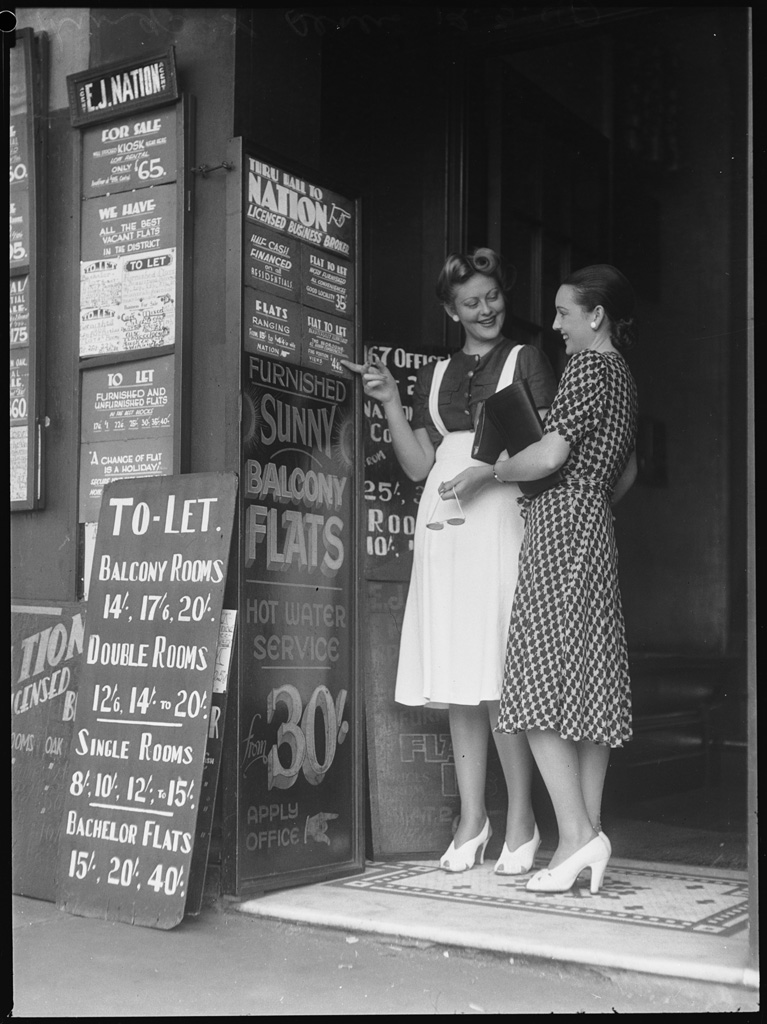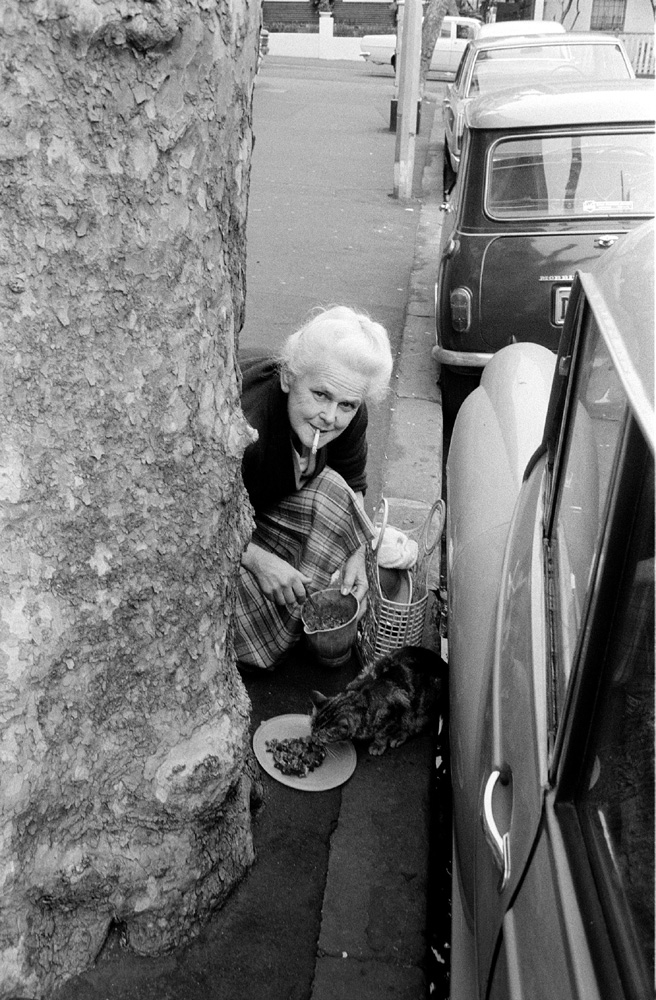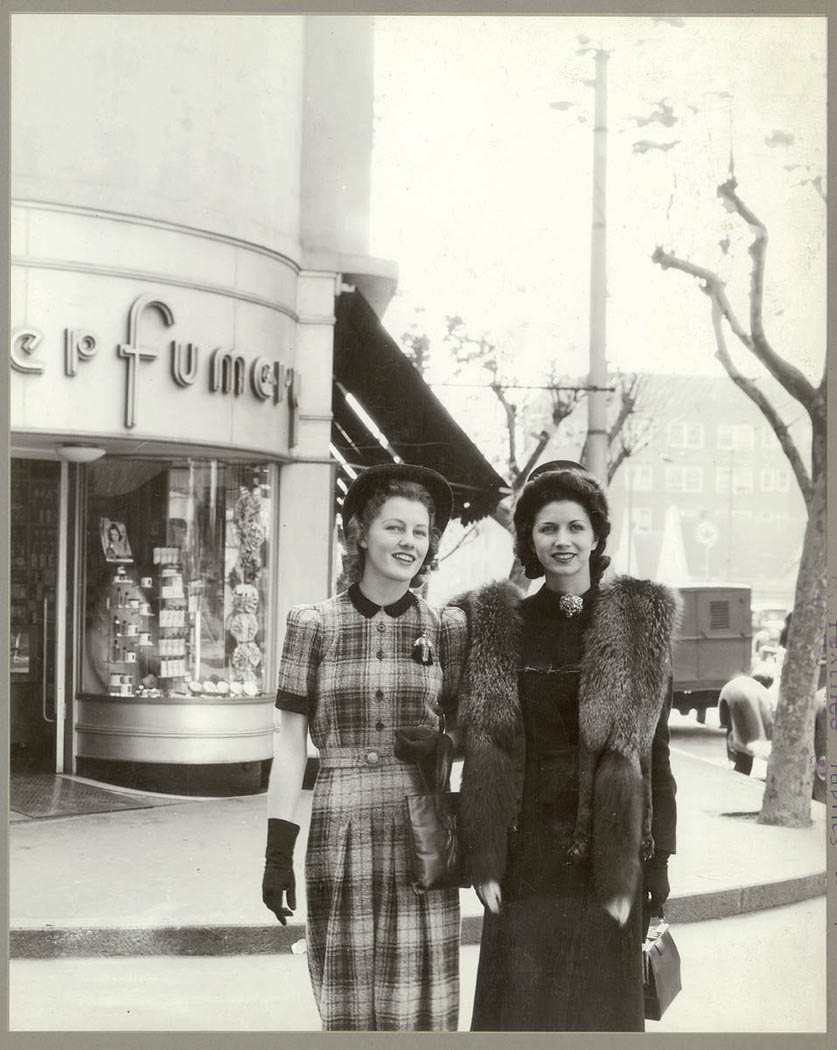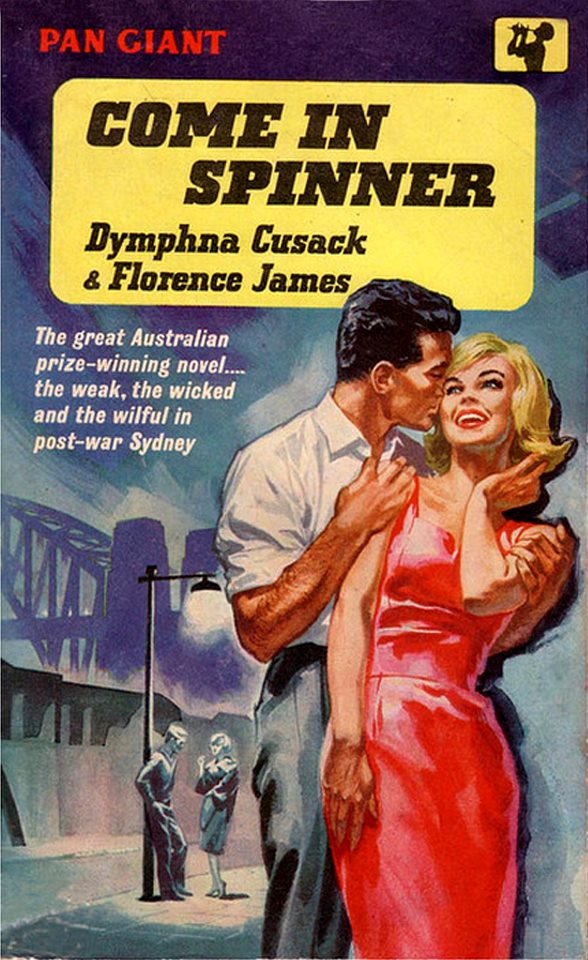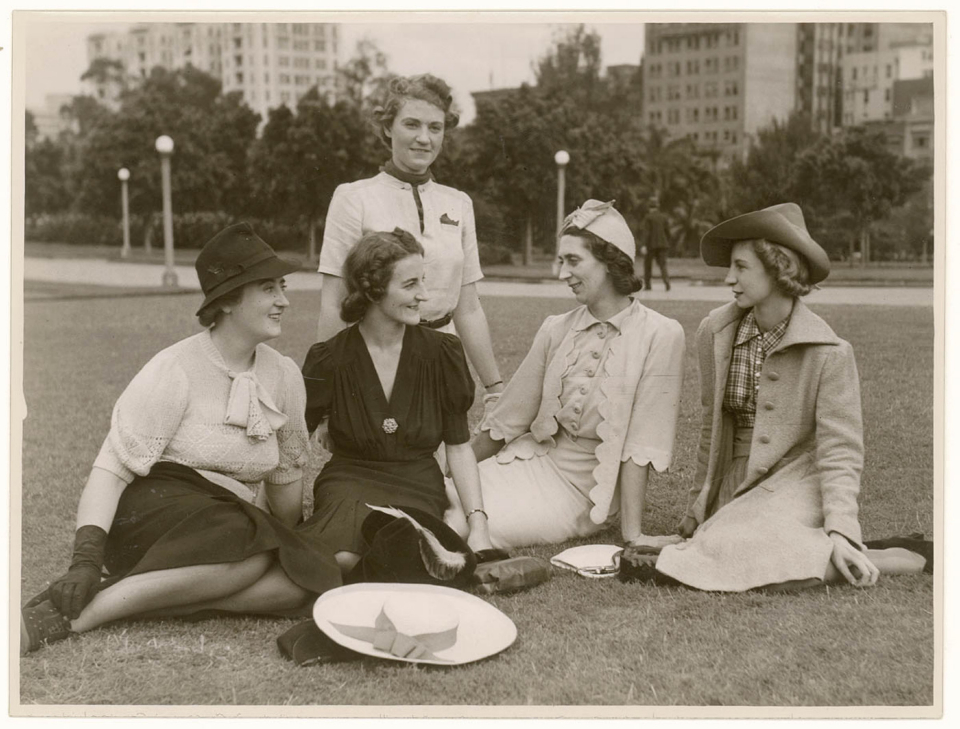The Dictionary of Sydney was archived in 2021.
A City of One's Own: Women's Sydney
Citation
Persistent URL for this entry
To cite this entry in text
To cite this entry in a Wikipedia footnote citation
To cite this entry as a Wikipedia External link
A City of One's Own: Women's Sydney
[media]Give me a little room somewhere with stars,
A view of the bridge, the smell of harbour water… [1]
Dorothy Hewett's 1968 poem, A Window on Sydney, is the starting point for a brief tour of women's Sydney. Hewett's loving celebration of the shuffling old ladies, cats, flower stalls—even the American pornographer in the flat upstairs—is one of many twentieth-century accounts of inner Sydney that celebrate it as a place of unique freedoms, sensual pleasures and dangers for women; and the harbour as a steady, vivid source of joy.
Freedom from the suburbs
[media]From the 1920s especially, a boom in apartment living on or near the harbour afforded greater freedoms to women. These flats, some in new buildings and others bedsits carved out of once-grand homes, offered privacy, access to work and the intellectual life of the city, an escape from unpaid domestic labour and freedom from the watchful eyes of family and suburban neighbours.
Women often chose to flat with other women, or alone. Delicatessens, restaurants and 'ham and beef' shops — where one could leave a plate before work to be picked up on the way home—freed many from cooking (a rudimentary act anyway, as many small flats contained little more than a single element or kettle). [2] In Jessica Anderson's novel, Tirra Lirra by the River [3], the heroine Nora describes the small apartment she shared with her husband in the 1940s in one of the subdivided Italianate mansions at the end of Wylde Street, Potts Point (Bomera still stands, opposite the naval base at Garden Island). In this bohemian enclave, Nora experiences a sexual and personal awakening, while one of her neighbours, a dressmaker, teaches her the skills she will later use to support herself.
[media]Other rooms also enabled women's entry into city life. For working class women, in the era before the six o'clock swill turned pubs into great beer barns, the warren-like rooms of their local were often a neighbourhood meeting place: though excluded from the front bars, women would meet in the women's lounges and sometimes even share domestic work like shelling peas. In the 1920s, troubled bohemian, Anne Brennan, would find lodgings in the rooms above Betsy's Cafe la Boheme in Wilmot Street, near Hyde Park. [4] For other women, especially from the country, there were rooming houses (often owned or run by women), or more pleasant institutions like the Country Women's Association hostel in Kings Cross and the Women's Club (founded in 1901) in Elizabeth Street, both still surviving. Quong Tart's clean, efficient tea rooms have a proud history in the feminising of the city, providing alternatives to pubs and restaurants where unaccompanied women often felt unwelcome. Louisa Lawson, owner of Australia's first feminist newspaper, The Dawn, met with members of The Dawn Club in Tart's cafes, including those at the Queen Victoria Markets. [5]
For many women, even if they were not working or living there, the city itself represented qualities — cosmopolitanism, joyous street theatre, and the busy anonymity of crowds — that were a relief from the conformist suburbs. In a key scene of Elizabeth Harrower's 1966 novel The Watch Tower [6], abused wife Laura escapes from her life of slave labour in suburban Manly to spend a day walking methodically around the city grid. Women writers, like Hewett or Ruth Park, often singled out for fond attention older, eccentric working-class women, apparently liberated by age and class from the stifling codes of behaviour their more well-off peers were expected to embody and uphold.
Dangers of the city
World War II allowed [media]more women to participate in the life of the city. The call up of more than 100,000 men into full-time war service meant many were able to find employment and financial independence for the first time. For some, as author Betty Roland recounts in The Devious Being, [7] the constant passage of military personnel through the port of Sydney created a busy, anonymous atmosphere conducive to sexual exploration. [media]This moment is also depicted by Dymphna Cusack and Florence James's 1951 bestseller, Come in Spinner [8], whose independent, apartment-dwelling heroines earn their living pampering the rich in the beauty salon of a glamorous (fictional) hotel on Macquarie Street. This novel sensationally staged the possibilities, contradictions and dangers of the city for women, with a special emphasis on the differing consequences of class. While the idle rich play, girls with fewer connections are forced by Manpower into low-paid factory jobs. A young woman abducted and raped in a brothel is almost imprisoned by the Children's Court, while another dies of an illegal abortion. Cusack's outspoken novel Jungfrau [9], which also featured the fatal consequences of an unwanted pregnancy, was even more outspoken in its investigation of the freedoms and limits of city-dwelling women's lives.
[media]Even in the inner city, well into the twentieth century, women's public and private freedoms were restricted. Australia's first policewoman, Lillian Armfield [10], spent much of her time policing women's, and especially girls', sexual mores; her biography, Rugged Angel [11] (authored by Vincent Kelly) describes her tracking of 'runaways' to brothels, boarding houses and sailors' beds. (Department stores also required Armfield's vigilance; supposedly they were the equivalent of Sydney's male 'cruising' spots, where older lesbians would find jobs to recruit younger staff). Though men were rarely prosecuted for sexual liaisons deemed inappropriate to public morals, girls considered 'wayward' or 'at risk' or convicted of the 'crime' of being unsupported by their parents, might find themselves subject to an invasive examination for sexually transmitted diseases and sent to institutions like the notorious Parramatta Girls' Home.
Yet, as Hewett's poem suggests, women have made a great connection with the city, especially its natural beauty, celebrating its capacity to comfort and inspire. In Jungfrau the characters tryst and discuss their troubles under the great arches of the Domain's Moreton Bay figs. In Tirra Lirra, Nora celebrates her bedroom in Elizabeth Bay with its view of 'people, flowers, cats, water, sky, seagulls, ships' as the lifelong pattern of 'what a room should be'. The theme continues to today in Fiona McGregor's Indelible Ink [12] in which a terminally ill woman finds great pleasure in both the bohemian inner city's risks and her lovingly tended, waterfront Mosman garden.
Activists
Women have also tended to be particularly active in the improvement and preservation of the city: from the women of Hunter's Hill, who worked with the Builders Labourers Federation to protect Kelly's Bush via the first of Sydney's Green Bans in 1971 to activist Juanita Nielsen who lost her life battling to save Potts Point's Victoria street from demolition. Among their number we must also count the novelists Eleanor Dark – among the first to insist on the Indigenous history of the harbour in her 1938 Waterway [13] – and Ruth Park, fictional chronicler of life of the inner city poor and rich imaginer of the city's past in the children's classic Playing Beattie Bow. [14] Park wrote that she was spurred to write her 1973 Companion Guide to Sydney by urgent dismay in the face of the great destruction of the city's old buildings in the 1960s: 'Oh, my poor old girl!' I used to cry,' she wrote, 'stepping aside to avoid trucks laden with enormous ironbark beams, black with age and pocked with axe marks.' [15]
We also see great strength exhibited by Indigenous women in the colony's early days: the Cameragal woman Barangaroo angrily warned her partner Bennelong against closeness with the colonists while the Eora teenager Patyegarang, collaborated with Lieutenant William Dawes in his tiny observatory, to preserve much of what remains to us of the Sydney language in his Language Notebooks. [16]
Intriguingly, historian Grace Karskens suggests that Indigenous women's places were probably within the water of the harbour itself. [17] It is interesting to observe how for settler women, the watery edges of the harbour so often appear, in their writing, as a richly enlivening, deeply ravishing and sustaining place. While Kenneth Slessor's famous poem Five Bells [18] immortalises Sydney Harbour as the grave of an angry dead man, a place where timeless darkness dwells in beauty, women's writing tends on the whole to depict it as a glittering promise, a talisman and a comfort, compared to the complicated pleasures found on land.
References
Grace Karskens, The Colony: A History of Early Sydney, Allen and Unwin, Sydney 2009
Vincent Kelly, Rugged Angel: The Amazing Career of Policewoman Lillian Armfield, Angus and Robertson Ltd, Sydney, 1961
Ruth Park, Companion Guide to Sydney, Collins, Sydney, 1973
Notes
[1] Dorothy Hewett, 'A Window on Sydney' first published in Windmill Country, Overland in conjunction with Peter Leyden Publishing House, Melbourne, 1968
[2] See the various account of apartment living in Mandy Sayer and Louis Nowra, In the Gutter…Looking at the Stars: A Literary Adventure Through Kings Cross, Random House, Sydney, 2000
[3] Jessica Anderson, Tirra Lirra by the River, first published Macmillan, South Melbourne, Victoria, 1978
[4] Peter Kirkpatrick, The Sea Coast of Bohemia: Life in Sydney's Roaring Twenties, University of Queensland Press, St Lucia, 1992
[5] Heather Radi, 'Lawson, Louisa (1848–1920)', Australian Dictionary of Biography, National Centre of Biography, Australian National University, http://adb.anu.edu.au/biography/lawson-louisa-7121/text12285, published in hardcopy 1986, accessed online 26 March 2014
[6] Elizabeth Harrower, The Watch Tower, first published Macmillan, South Melbourne, Victoria, 1966; republished by Text Classics, 2003, with an introduction by Joan London
[7] Betty Roland, The Devious Being, Angus and Robertson, Sydney, 1990
[8] Dymphna Cusack and Florence James, Come in Spinner, first published Heinemann, London, 1951
[9] Dymphna Cusack, 'Jungfrau', first published by The Bulletin, Sydney, 1936
[10] Vincent Kelly, Rugged Angel: The Amazing Career of Policewoman Lillian Armfield, Angus and Robertson Ltd, Sydney, 1961
[11] Vincent Kelly, Rugged Angel: The Amazing Career of Policewoman Lillian Armfield, Angus and Robertson Ltd, Sydney, 1961
[12] Fiona McGregor, Indelible Ink, Scribe Publications, Brunswick, Victoria, 2010
[13] Eleanor Dark Waterway, first published Collins, London, 1938
[14] Ruth Park, Playing Beattie Bow, Nelson, West Melbourne, Victoria, 1980
[15] Ruth Park, Companion Guide to Sydney, Collins, Sydney, 1973
[16] See The Notebooks of William Dawes on the Aboriginal Language of Sydney online at http://www.williamdawes.org
[17] Grace Karskens, The Colony: A History of Early Sydney, Allen and Unwin, Sydney 2009, p 44
[18] Kenneth Slessor, Five Bells, first published FC Johnson, Sydney, 1939
.



